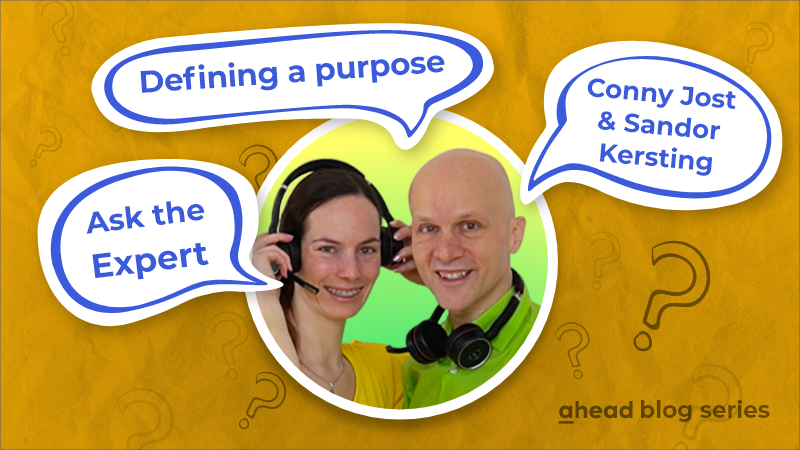In this year's edition of Ask the Expert, we interviewed Conny Jost and Sandor Kersting, the founders of OverTheMaze. Together, they support entrepreneurs and organizations in shaping their business based on purpose.
Conny and Sandor, who are you and what motivates you?
When I want to introduce Sandor, his 3 most important values immediately come to mind: curiosity, adventurous and vibrancy. Working with Sandor is a wonderful adventure. Because in this adventure, you walk a path together and decide together what that path looks like. In other words, you know that no matter how the shared path develops, it will bring added value to both of you.
Introducing Conny is easy. She is a bright, cheerful person who enjoys connections and loves to see things develop. Whether it's relationships, companies or joint experiments, she pays attention to continuous development, takes great pleasure in the details and, above all, keeps an eye on the benefits for everyone.
Walking a path together with her feels sunny and unifying. It gives you the certainty that this will result in mutual growth for everyone.
What moves us together is that we really love creating living environments in which people and companies can flourish. When we enable others to really live their business and not just run it, we know that the world has become a richer and more valuable place. This moves us, motivates us and makes us a little happier every time.
What is the difference between vision, mission, values, and purpose
Oh, that's a great question. When we started OverTheMaze, we asked ourselves the same thing, and we're happy to share the answers we found that were most helpful to us.
- The vision enables a company to set a clear goal for the distant future that it can strive for and achieve.
- The values a company lives by show the principles and standards that are important for how it acts internally and externally.
- The mission statement outlines the fundamental reasons for the company's existence, the "why," i.e., what the company wants to achieve.
- The purpose that exists within a company provides a broad direction. The company moves in this direction.
- This purpose gives people in the company a simple clarity about what is important. It strengthens the connection between them and thus with the company. And purpose enables long-lasting, inner joy about working together.
Suppose an organization wants to define its purpose. What is your tip and how should they proceed?
Purpose is something that is already there. Purpose is active. It is created by people and always shines through in their actions and experiences.
You can find it in what has already happened, in the values you live by, in what is important to you to do and in what draws you into the future together. It is a powerful guide. And if you put the essence of this into a short sentence that everyone involved feels emotionally because it moves them, then you have purpose in plain sight.
Purpose exists on different levels. On a very individual level, it is the personal purpose. You can use the following as a guiding question for yourself: "What is it that is so important that you keep advancing and creating it in your life?"
At the level of an organization, it is Shared Purpose and the following guiding question helps: "What is always created and what is always visible by working together as an organization?"
Or one level above that is the Overarching Purpose, which is detached and goes beyond the individual organization. "What do we repeatedly achieve in the big picture and what do we contribute to?" This is where you make the impulse visible, the impact.
Depending on the level at which you want to make purpose tangible in your company, involve as many people as possible. Get them actively involved.
In your experience, what is the most difficult thing about defining purpose?
In our experience, there are two possible hurdles. A clear YES to purpose and the concrete use of purpose. Depending on where the company is in its development.
By a clear YES, we mean that it is relevant to decide on the purpose. Because only when a company has decided to follow a purpose can it live it.
Once you as a company have made your purpose visible, you need to take the next important step, which is to actually use it. This means that you consciously incorporate the purpose and its meaning into your company's decisions. On the other hand, the corporate culture makes it possible for employees to take the space to consciously align themselves with the purpose. So that they can feel and use the purpose in their actions.
Why is this topic so important, and why should companies invest in it
In our view, a company behaves like a living organism that likes to change and move forward. In doing so, it helps the company and the people who work there to understand their purpose.
A shared purpose provides clarity, identification, and direction, detached from day-to-day details and especially in changing situations. Because this common guiding principle shows: "This is what we live for and what is important to us."
The specific effects are:
- More drive - "I am part of something that is relevant, something that is important to me and to us."
- More trust - "I know that we all want to move in this common direction."
- Simpler decisions - because there is a shared, overarching direction.
How should companies involve their employees in defining their purpose?
Employees from different departments each have a different view of the company. As already mentioned, purpose already exists and is present throughout the entire company.
To ensure that as many employees as possible can easily and quickly identify with the purpose, find themselves in it and strengthen it right from the start, it helps to involve as many, ideally all, employees as possible in the process.
If the company has clearly defined its purpose, it is also easy for newcomers to latch onto it, embrace it and live it together with the others.
What is the secret recipe for sustainably anchoring purpose in the organization?
That it is seen and shared how this purpose is actively lived in the organization. In other words, how your purpose becomes visible in individual, concrete situations. How it comes to light in experiences, adventures and, above all, everyday occurrences. And in all areas of the company.
For example, internally, when HR hires new employees and tells them how this purpose has become tangible for new colleagues in the processes they have put into practice. At the customer's site, for example, when the new system is installed and your employees tell their colleagues how pleased the customer was with the positive process. Or in sales, when your sales employees show how they incorporate purpose into conversations and presentations for prospective customers.
And you can now promote this exchange and sharing as an organization by anchoring it as a fixed component in meetings or at events and especially by integrating it into everyday business life and making it easy.




